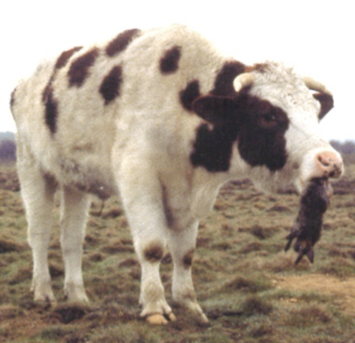
While I have been quite handy with a shotgun complete with MagLite duct taped to the barrel, dashing after [insert predator here] has sent the poultry into a full-blown panicked frenzy in the wee hours of the night, it’s not something I particularly enjoy. I’ve battled coyote, bears, bobcats, skunks, raccoons, rats and stray dogs harassing, even killing the assorted menagerie of fowl, swine and ruminants, both large and small. In addition to shooting predators, I’ve trapped them, poisoned them and fenced them out.
Venturing into bigger flocks and larger herds, I began to realize that losing an occasional hen to having its head chewed off by raccoon was giving way to a doe having kids attacks during or shortly after birth by predatory Black Buzzards and coyotes attacking full grown goats. Encountering each of these situations was a tantamount to starring in my own personal horror flick. Running the numbers on the losses, however, is where the real nightmare took hold. There had to be a better way.
Enter the livestock guardian dog (LGD)
Archaeological evidence shows man has worked in tandem with LGDs for more than six thousand years in domestic livestock production. Out of that relationship, the modern LGD is now found throughout the world in agrarian and herding cultures, both stationary and nomadic. From the sleek, yet powerful Anatolian Shepherds of Turkey bred to prevent attacks from bears, jackals, wolves, and cheetahs to the massive mop-like Hungarian Komondor, also fearless of wolves and bears, there are currently, over thirty different breeds are recognized, all exhibiting similar same traits.
- Large
- Naturally protective
- Present themselves to the flock/herd in a submissive posture
- Independent
- Trustworthy
- Highly attentive
- Hardy
Due to these inherent traits critical to their effectiveness as an LGD, ownership must not be taken lightly. While many people do keep LGDs as companions, it must be stressed that a working LGD is not a pet. I tend to tell people, you can make a pet out of an LGD, but you cannot make an LGD out of a pet. And while there are exceptions to this, chances are with a companion LGD, you will encounter inherent guardian traits that will try your patience at times—barking, shedding, slobbering, over-protectiveness verging on aggression, roaming, and obstinacy.
These natural behaviors each serve a specific purpose in LGDs. For instance, barking, slobbering and shedding are all preventative measures, alerting potential predators that there is a very large dog on duty. Similarly, roaming has been the bane of many LGD breeds. While you at first may think this a negative trait, consider how LGDs function.

Most effective when working in pairs, the alpha dog routinely makes a circle—as much as a two-mile radius—of the home base while leaving the more submissive partner to stay with the flock/herd. Along the way, the alpha dog marks its territory with an assortment of scents using urine, feces, saliva and fur. On expansive operations and in nomadic and semi-nomadic cultures, these traits are highly desirable in a working LGD, but not so much for the suburban and urban environments. Back at the home base, LGDs continue to alert their presence to predators with repetitive barking.
That’s not to say LGDs are the untrainable thugs of the dog world; quite the opposite. The key to working well with an LGD is understanding that these dogs are extremely intelligent left to their own devices and they require an equal understanding from their humans.
For instance, many LGD owners often jump to conclusions when finding a dog with a half-eaten kid or lamb or “worrying” a particular animal in the flock. These dogs understand that still-born and weak animals attract predators. They have also been known to take down aged and infirmed members of the group, strategically placing themselves between the group and the carcass, leaving it to predators purposely. One of the most interesting traits I have repeatedly witnessed with my own LGDs is they will not take an aggressive position against potential predators as long as the predator does not exhibit interest in the flock/herd. However, at the first inkling of stress on their charges, the LGDs will spring into action with shock and awe.
As for singling out particular animals in a flock, this is where you must learn to pay attention to your LGD, especially when managing large numbers of livestock. An LGD can pick out a sick or injured animal long before you will notice it. They will lick a wound, clean up a scouring animal, lay next to or on top of chilled/downed stock and point out females who have aborted.

Because LGDs work best in pairs, I feel I must mention at this point another trait that can be unsettling to owners—dogs fighting among each other. Just as Muhammad Ali did not become the greatest boxer of all time without training, neither does an LGD become prepared to take on top-tier predators without practice. Be warned, you will see what appears to be the most vicious of dog fights—snarling, snapping, screaming, rolling around in the dirt, standing on hind legs, chasing, rolling. It looks and sounds awful. At times, there will be blood. But if and when the day arrives that your LGD is faced with defending your stock, it will be extremely prepared as long as you resist the urge to intervene in what appears to be aggression in their day to day rough housing.
Although LGDs’ protective nature is naturally inherent in the breeds, that does not preclude basic obedience. While the LGD does not require specialized commands, like herding dogs, it is critical that they are taught the basic commands–here/come, sit/down, stay/wait, no/leave it. Don’t worry about the words, it’s the actions that matter—calling a dog to your side from the fields, having them stay out of your way or not enter/exit an area and to disengage from their current actions. This level of obedience is not as critical for the day-to-day working of the dogs as it is for when the LGDs themselves require care.
However, LGDs can become obstinate, especially when it comes to the introduction of a new dog (especially herding-type dogs) once they have established their position as the resident protector. They will blatantly ignore all commands if in their mind they believe the newcomer is creating stress. Bear in mind, this can include humans.

Another critical aspect of training for many LGDs is learning to respect electric fencing. Over the years I have bred and trained Great Pyrenees for LGDs and I can attest that every single puppy will test an electric fence. They will not see their siblings getting shocked and learn. Their parents will not teach them about the fence. This is strictly trial and error. If you are starting out with a puppy, there are two things to remember. One, you want to teach your dog to stay on the inside. That means if they squirt out through the electric wires during their learning phase, do not let them shock themselves trying to get back to their flock/herd, but take them through a gate. Two, never leave an untrained dog alone with electrified netting until the dog fully comprehends the fence is electrified and will avoid it. This scenario is not only dangerous to the dog, but if you have stock within the netting, they will ultimately be loose as a panicked LGD will quickly take down netting in an effort to get away from the pain.
Despite being hardy dogs, your LGD will still need routine care, including vaccinations (especially rabies), parasite control, medical care, and sterilization if they are not to be used for breeding. Working/breeding dogs should be properly socialized and trained enough so as not to endanger the welfare of either owner or bitch during and after whelping.
 Another attribute of many LGDs with which humans tend to interfere because we anthropomorphize our dogs is their coats. Many breeds have light-colored fur of varying types and length, often double-coated like the Great Pyrenees or corded such as the Komondor. We want to bathe them when they roll in something dead, shave them in the heat of summer and trim their “pantaloons” or hindquarter mats in late fall or winter. Unfortunately, we are often doing little more than a disservice as their coats are natural protection against the elements, parasites and in some cases, act as “armor” against predator attacks.
Another attribute of many LGDs with which humans tend to interfere because we anthropomorphize our dogs is their coats. Many breeds have light-colored fur of varying types and length, often double-coated like the Great Pyrenees or corded such as the Komondor. We want to bathe them when they roll in something dead, shave them in the heat of summer and trim their “pantaloons” or hindquarter mats in late fall or winter. Unfortunately, we are often doing little more than a disservice as their coats are natural protection against the elements, parasites and in some cases, act as “armor” against predator attacks.
Be forewarned, a well-bred and started or trained LGD does not come cheap or free. While there are many rescues full of LGD breeds, bear in mind you would most likely be inheriting someone else’s problem. If you are serious about adding an LGD to your farm, do your homework on what specific breed’s personality traits will best fit your operation.
For example, I chose Great Pyrenees based upon my experience with them being “gentle giants” as opposed to many of the farms and ranches I visited where the owners first had to pen other more aloof and aggressive breeds before a stranger could enter the pasture or handle stock. For me, I knew there would be many strangers visiting my farm, but if my operation were very rural covering a large expanse of property, I would have opted for the latter personality traits.
In addition to their livestock guarding related duties, LGDs are equally protective of the physical locale meaning they will also deter two-legged predators and they make an excellent “door bell”.
Overall, the choice to employ an LGD in has turned out to be most worthwhile in terms of prevention and are well worth the investment of money and time.




